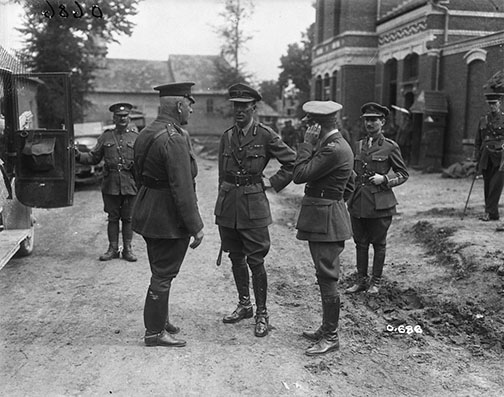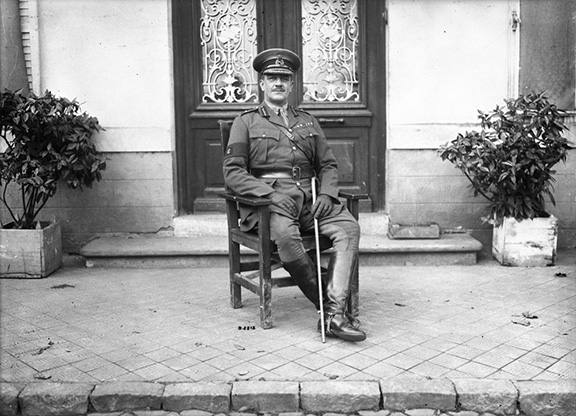Somme, 1918
First World War
Date
21 March - 5 April 1918
Geographical Parameters
No geographical parameters defined.
Context
A group honour incorporating the “Battle of St. Quentin”, the “First Battle of Bapaume”, the “Battle of Rosières”, the “First Battle of Arras, 1918”, the “Battle of the Avre”, and the “Battle of the Ancre, 1918”, formally entitled “The First Battles of the Somme, 1918”, and itself being part of “The Offensive in Picardy (21 March – 5 April, 1918)”Footnote 1.
Description
The Honour “Somme, 1918” was awarded as a Campaign Honour for the defence against the German Spring offensive in this region. Launched on 21 March, the German offensive named Operation Michael was intended to knock the British out of the war before American forces could arrive in large numbers. Using infiltration tactics the German attack was planned and rehearsed starting in January. Although the British forces in the area had attempted to adopt a form of elastic defence there were insufficient number to resist the German assault. Over the next few weeks the Germans penetrated some 40 miles into the British lines. Various formations were moved in to attempt to stop them. The Canadian Cavalry Brigade (Brigadier-General J.E.B. Seely) was the first Canadian formation called into action, playing a part in arresting the German advance near the town of Moreuil. The 1st Canadian Motor Machine Gun Brigade (a battalion-sized unit) was also quickly rushed to help stop the German advance. In their “Motors”, as their armoured cars were called, they were able to quickly move and help cover British withdrawals since many of the British machine gun positions had been captured. The only component of the Canadian Corps to be involved in this campaign was the 2nd Canadian Division (Major-General Sir H.E. Burstall), temporarily assigned to the Third Army to re-establish a defensive line.
In February 1918, prior to the opening of the German campaign, Canadian railway troops, such as the 6th Canadian Railway Battalion (formerly the 228th Battalion, CEF) had been dispatched to the Fifth Army rear areas to construct a light rail system to better serve the front line. The enemy threat was such that these hitherto unarmed units were issued with and practised on, service rifles. When the storm broke on 21 March these railway construction battalions became, in a few instances, the only organized and cohesive military units in the rear areas. The units continued in their duties under enemy shell fire and air attack until withdrawn.

Gen. Sir Sam Hughes (left fore) visiting the Front, talking with Brig.-Gen. Seely (middle fore). Aug. 1916. Location unknown.
Credit: Canada. Department of National Defence/PA-000599Library and Archives Canada/PA-000599; (MIKAN no. 3221015)

Major-General Sir Henry Edward Burstall was General Officer Commanding the 2nd Canadian Division. Location unknown. December, 1917.
Credit: Canada. Department of National Defence/Library and Archives Canada (MIKAN no. 3213482)
Awarded to:
Currently Serving Units
- The Algonquin Regiment
Awards to the 228th Canadian Infantry Battalion, CEF (GO 5/31) and The Algonquin Regiment (GO 88/31) - The Argyll and Sutherland Highlanders of Canada (Princess Louise's)
Awards to the 19th Canadian Infantry Battalion, CEF (GO 110/29) and The Argyll and Sutherland Highlanders of Canada (Princess Louise's) (GO 110/29) - The British Columbia Regiment (Duke of Connaught's Own)
Awards to the 29th Canadian Infantry Battalion, CEF (GO 123/29) and The Vancouver Regiment (GO 71/30) - The Essex and Kent Scottish
Awards to the 18th Canadian Infantry Battalion, CEF (GO 110/29) and The Essex Scottish (GO 110/29) - The Fort Garry Horse
Award to The Fort Garry Horse (GO 5/31) - Lord Strathcona's Horse (Royal Canadians)
- Award to Lord Strathcona's Horse (Royal Canadians) (GO 88/31)
- The Nova Scotia Highlanders
Awards to the 25th Canadian Infantry Battalion, CEF (GO 123/29) and The Colchester and Hants Regiment (GO 110/29) - The Princess of Wales' Own Regiment
Awards to the 21st Canadian Infantry Battalion, CEF (GO 123/29) and The Princess of Wales' Own Regiment (GO 110/29) - The Queen's York Rangers (1st American Regiment) (RCAC)
Awards to the 20th Canadian Infantry Battalion, CEF (GO 110/29), the 127th Canadian Infantry Battalion, CEF (GO 71/30), The Queen's Rangers, 1st American Regiment (GO 110/29) and The York Rangers (GO 71/30) - Royal 22e Régiment
Award to the Royal 22e Régiment (GO 110/29) - The Royal Canadian Dragoons
Award to The Royal Canadian Dragoons (GO 5/31) - The Royal Canadian Hussars (Montreal)
Awards to the 1st Canadian Motor Machine Gun Brigade, CEF (GO 110/29) and the 1st Motor Machine Gun Brigade (GO 110/29) - The Royal New Brunswick Regiment
Awards to the 26th Canadian Infantry Battalion, CEF (GO 110/29) and The Saint John Fusiliers (GO 110/29) - The Royal Regiment of Canada
Award to The Royal Grenadiers (GO 110/29) - The Royal Regina Rifles
Awards to the 28th Canadian Infantry Battalion, CEF (GO 110/29) and The Regina Rifle Regiment (GO 110/29) - The Royal Winnipeg Rifles
Award to the 27th Canadian Infantry Battalion, CEF (GO 123/29) - The South Alberta Light Horse
Awards to the 31st Canadian Infantry Battalion, CEF (GO 110/29) and The South Alberta Regiment (GO 110/29)
Units on the Supplementary Order of Battle
- 12th Manitoba Dragoons
Award to The Border Horse (GO 59/32) - 38th Field Battery, RCA
Awards to the Machine Gun Squadron, Canadian Cavalry Brigade, CEF, and the 1st Cavalry Machine Gun Squadron (GO 5/31) - Victoria Rifles of Canada
Awards to the 24th Canadian Infantry Battalion, CEF (GO 110/29) and The Victoria Rifles of Canada (GO 110/29)
Disbanded Units
- 1st Canadian Pioneer Battalion, CEF
Award to the 1st Canadian Pioneer Battalion, CEF (GO 88/31) - 2nd Canadian Pioneer Battalion, CEF
Award to the 2nd Canadian Pioneer Battalion, CEF (GO 123/29) - 107th Canadian Pioneer Battalion, CEF
Award to the 107th Canadian Pioneer Battalion, CEF (GO 123/29) - The Manitoba Regiment
Award to The Manitoba Regiment (GO 123/29) - The North Alberta Regiment
Awards to the 31st Canadian Infantry Battalion, CEF (GO 110/29) and The North Alberta Regiment (GO 110/29)